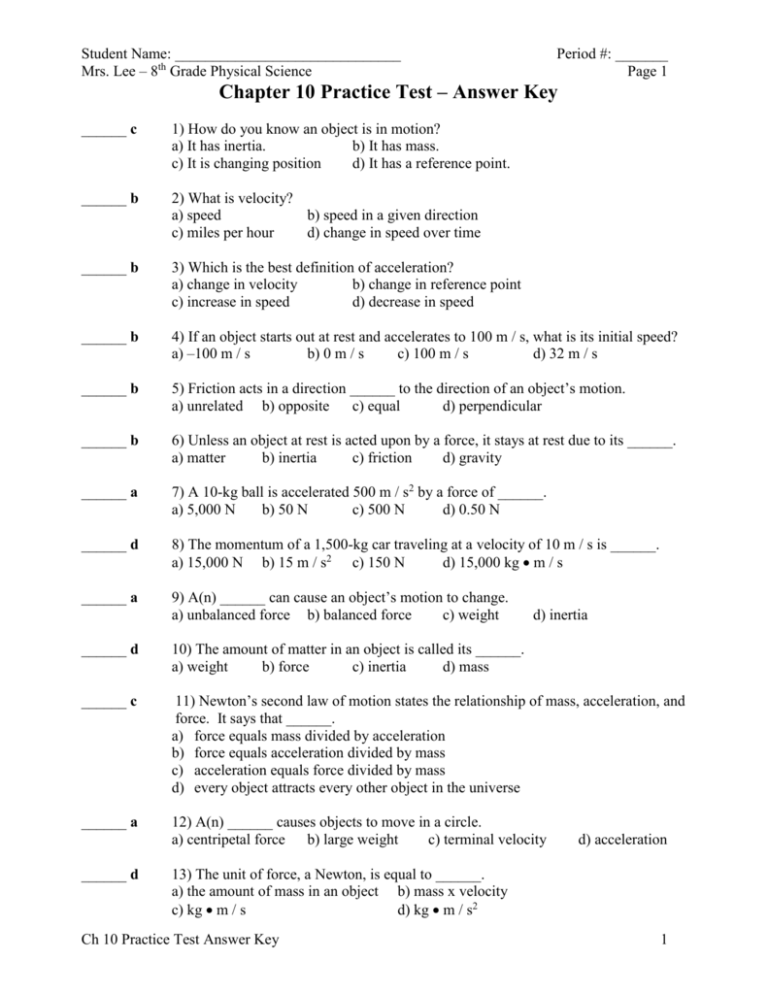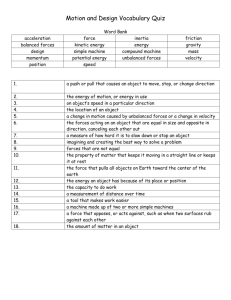Answer
advertisement

Student Name: ______________________________ Mrs. Lee – 8th Grade Physical Science Period #: _______ Page 1 Chapter 10 Practice Test – Answer Key ______ c 1) How do you know an object is in motion? a) It has inertia. b) It has mass. c) It is changing position d) It has a reference point. ______ b 2) What is velocity? a) speed b) speed in a given direction c) miles per hour d) change in speed over time ______ b 3) Which is the best definition of acceleration? a) change in velocity b) change in reference point c) increase in speed d) decrease in speed ______ b 4) If an object starts out at rest and accelerates to 100 m / s, what is its initial speed? a) –100 m / s b) 0 m / s c) 100 m / s d) 32 m / s ______ b 5) Friction acts in a direction ______ to the direction of an object’s motion. a) unrelated b) opposite c) equal d) perpendicular ______ b 6) Unless an object at rest is acted upon by a force, it stays at rest due to its ______. a) matter b) inertia c) friction d) gravity ______ a 7) A 10-kg ball is accelerated 500 m / s2 by a force of ______. a) 5,000 N b) 50 N c) 500 N d) 0.50 N ______ d 8) The momentum of a 1,500-kg car traveling at a velocity of 10 m / s is ______. a) 15,000 N b) 15 m / s2 c) 150 N d) 15,000 kg m / s ______ a 9) A(n) ______ can cause an object’s motion to change. a) unbalanced force b) balanced force c) weight d) inertia ______ d 10) The amount of matter in an object is called its ______. a) weight b) force c) inertia d) mass ______ c 11) Newton’s second law of motion states the relationship of mass, acceleration, and force. It says that ______. a) force equals mass divided by acceleration b) force equals acceleration divided by mass c) acceleration equals force divided by mass d) every object attracts every other object in the universe ______ a 12) A(n) ______ causes objects to move in a circle. a) centripetal force b) large weight c) terminal velocity ______ d d) acceleration 13) The unit of force, a Newton, is equal to ______. a) the amount of mass in an object b) mass x velocity c) kg m / s d) kg m / s2 Ch 10 Practice Test Answer Key 1 Student Name: ______________________________ Mrs. Lee – 8th Grade Physical Science Period #: _______ Page 2 Chapter 10 Practice Test – Answer Key ______ c 14) An object in free fall ______ until it reaches terminal velocity. a) decreases in mass b) slows down c) accelerates d) is unbalanced ______ b (force) 15) A push or a pull is a weight. a) True b) False ______ a 16) Friction between two objects that are not moving is static friction. a) True b) False ______ a 17) If gravity is the only force acting on an object, the object is in free fall. a) True b) False ______ b (mass) 18) The measure of the amount of matter in an object is the object’s force. a) True b) False ______ a 19) The momentum of an object depends on its mass and its velocity. a) True b) False ______ b (the same object) 20) Forces can be added together only if they are acting on different objects. a) True b) False ______ a 21) According to Newton’s second law of motion, acceleration increases as force increases, if mass stays the same. a) True b) False ______ a 22) The force due to gravity is stronger if two objects are closer. a) True b) False ______ b (gravity) 23) The force of friction acts between all objects in the universe. a) True b) False ______ a 24) A satellite in orbit around Earth is always falling toward Earth. a) True b) False ______ c 25) A force is described by ______. a) its strength only b) its direction only ______ c ______ b 26) What is the SI unit for force? a) meter b) meters per second c) its strength and direction c) Newton 27) When the forces acting on an object are balanced, the net force on the object is ______. a) less than 0 b) exactly 0 c) more than 0 Ch 10 Practice Test Answer Key 2 Student Name: ______________________________ Mrs. Lee – 8th Grade Physical Science Period #: _______ Page 3 Chapter 10 Practice Test – Answer Key ______ c 28) Friction acts ______. a) in the same direction as motion b) only on objects that are not in motion c) in the opposite direction as motion ______ c 29) The friction on an object moving through water or air is ______. a) rolling friction b) sliding friction c) fluid friction ______ a 30) The amount of gravity between two objects depends on their masses and the ______. a) distance between them b) friction between them c) total velocity of the objects ______ c 31) The force of gravity on an object is known as its ______. a) acceleration b) mass c) weight ______ a 32) Air resistance acts in what direction on a falling object? a) upward b) sideways c) downward ______ b 33) A(n) ______ causes an object’s motion to change. a) inertia b) unbalanced force c) balanced force ______ b 34) Newton’s third law says that for every action there is an equal and opposite reaction. This law says that forces ______. a) do not act on moving objects b) comes in pairs c) act only in the opposite direction of motion ______ a 35) Unbalanced forces change an object’s motion. a) True b) False ______ b 36) Friction causes moving objects to speed up. a) True b) False ______ b 37) The force of gravity between objects gets stronger as the objects move farther apart. a) True b) False ______ a 38) The inertia of an object depends on its mass. a) True b) False ______ a 39) A centripetal force is the force that keeps a satellite in orbit. a) True b) False Ch 10 Practice Test Answer Key 3 Student Name: ______________________________ Mrs. Lee – 8th Grade Physical Science Period #: _______ Page 4 Chapter 10 Practice Test – Answer Key The diagram below shows two balls. Use the diagram to answer the following 3 questions: ______ b 40) Calculating: The momentum of an object is its mass times its velocity. What is the momentum of Ball A? a) 1 kg m /s b) 2 kg m /s c) 3 kg m / s ______ a 41) Calculating: What is the momentum of Ball B? a) 0 kg m /s b) 1 kg m / s c) 10 kg m / s ______ b 42) Applying Concepts: If Ball A hits Ball B, what will the total momentum of the two balls be after the collision? a) 1 kg m / s b) 2 kg m / s c) 3 kg m / s Use the graph below to answer the following 2 questions: ______ b 43) Interpreting Graphs: What is the object’s speed at 3 seconds? a) 19.6 m / s b) 29.4 m / s c) 39.2 m / s ______ b 44) Applying Concepts: This graph shows an object in free fall. What is the only force acting on this object? a) air resistance b) gravity c) terminal velocity Ch 10 Practice Test Answer Key 4





